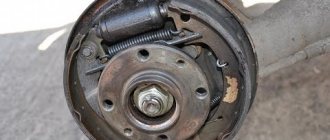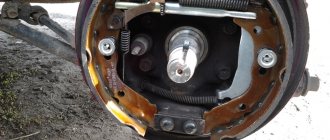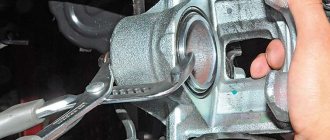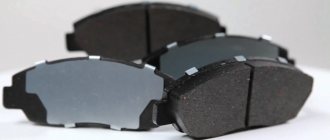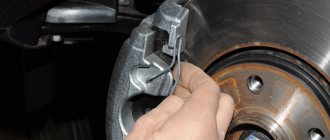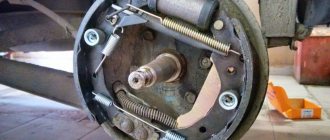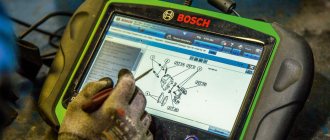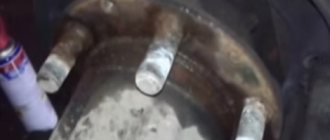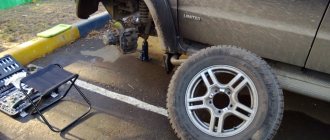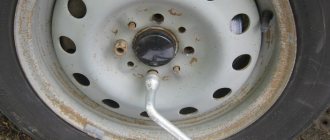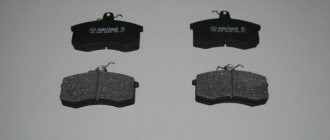on the Daewoo Lanos are worn out. Measurement of the thickness of the friction material showed less than 2 mm . Therefore, the front brake pads need to be replaced. The manufacturer does not regulate the service life of brake pads, but experts advise replacing them approximately once every 50,000 km , or even more often, depending on the quality of the friction material and driving style.
Replacing brake pads
Detailed graphic instructions on how to change the front and rear brake pads with your own hands. Replacing brake pads on your car yourself Read more
The right and left pads are changed at the same time. Replacement is not carried out separately.
Changing brake pads on Lanos (VIDEO + PHOTO instructions)
Brakes are one of the main functional systems of a car. Braking forces determine the level of driving dynamics and are also an integral element of many driving maneuvers. Failure or improper operation of the brake system can result in an accident. According to statistics, almost 30 emergency situations occur precisely because of vehicle brake malfunctions.
At the slightest suspicion of improper operation of the brake system in a ZAZ Lanos, it is necessary to inspect the elements of the brake calipers and discs.
Otherwise, that is, if you keep the brake system in a disrepair, you will have to change all the brake components (pads, calipers and discs on all wheels), which can be very, very expensive.
Diagnostics of the brake system on ZAZ Lanos
Improper operation of the brakes immediately makes itself felt. The consequences of a faulty brake system are:
- Extraneous noise from wheels when squeezing the brakes at speed
- Inadequate response of the brake system to brake pedal efforts
In addition, periodically you need to visually inspect the brake calipers and discs for excessive wear. Most often, brake pads wear out; changing them will be discussed in this review.
TIP: It is best to change brake pads on all calipers that use a pad system.
As a rule, a planned change of brake pads on a ZAZ Lanos 1.5/1.6 should be carried out at intervals of at least 40 thousand km.
Stages of changing brake pads on the front wheels of Lanos
1. We put the car on the handbrake.
2. Loosen the wheel bolts.
3. Raise the serviceable area of the car with a jack and remove the wheel.
4. Press out the brake disc piston with a long screwdriver.
5. Let's start disassembling the brake caliper. Unscrew the fastening bolts of the clamping mechanism and remove the caliper covers.
6. Removing the brake pads
TIP: Pay attention to the anthers and mounting brackets; if they are worn out, then we replace them. Therefore, along with the pads, there is a reason to immediately purchase several sets of anthers and mounting brackets. This pleasure is not that expensive.
7. If necessary, replace the anthers with brackets.
8. We put new pads in place of the worn ones.
9. We assemble the brake caliper, put the wheel in place and remove the jack.
10. We repeat all the above operations with all wheels that use the shoe brake system.
11. We do a test drive.
As you can see, there is nothing complicated at all in the technological operation of changing brake pads on a ZAZ Lanos 1.5. Even a person who does not have deep knowledge in the field of automotive technology can quickly cope with this work.
I hope my review was helpful. Follow the release of new materials from the online store ZAZ-Shop . See you.
Defective brake mechanism
Having driven the car onto a flat area, put it in gear and the handbrake, then slightly loosen the wheel bolts - it is much more difficult to tear them off with a hanging wheel. Then jack up the car and remove the wheel completely.
The first thing you need to pay attention to is the condition of the brake disc surface. If there are deep marks on it, the brake pads must be replaced regardless of their remaining thickness. If the working surfaces wear evenly, proceed to measurement.
The manufacturer's standards require replacing the brake disc when it wears down to a thickness of less than 19 mm; the thickness of the linings on the pads should not be less than 1 mm.
Also inspect the guide bushing boots for cracks or breaks. In this case, the wear of the guides will accelerate significantly. The current degree of wear can be assessed by sharply shaking the caliper body from side to side: noticeable play is a sign of the need to install a new guide repair kit.
Replacement process
First of all, it is necessary to consider the reasons for replacing the pads on Daewoo Lanos. They are the same for all vehicles. Reasons for replacing pads:
- wear of the linings (minimum thickness - 2 mm);
- unreliable connection of the linings with the base;
- the appearance of too much oil on working surfaces;
- presence of mechanical damage (chips or grooves).
Preparatory activities before replacing Lanos pads
To remove unusable parts and install new ones, the following are used: sliding pliers, a wrench for wheel nuts, as well as keys for “10” and “18”. The process takes a specialist about 40 minutes. As for a novice mechanic or an ordinary motorist, the replacement may take a little longer.
Before removing the pads, it is mandatory to check that the brake fluid tank is full. Its necessity is easily explained by the fact that completing the installation of a new part will lead to an increase in the fluid level in the master cylinder reservoir. You can take care of reducing its quantity with a regular syringe, which you will probably find in your first aid kit (a medical bulb can serve as an alternative). It will easily penetrate into the desired container and pump out the excess.
Step-by-step instructions for replacing pads on a Daewoo Lanos will speed up the process and learn about all the nuances relating to the front brake mechanisms:
First, open the hood and unscrew the brake reservoir cap.
Next you need to unscrew the wheel. You will see the brake mechanism assembly.
Loosen the caliper guide bolts, and then remove the bolt completely.
The lower cylinder mounting bolt is important for us:
Release the brake hose.
Using a brush, clean the brake mechanism from dirt, and then unscrew the bottom bolt. When performing this work, it is best to use a spanner wrench, and this is because using an open-end wrench can lead to breaking the edge of the bolt. Applying force to the key is only necessary when starting, after which the bolt can simply be unscrewed by hand.
Pad selection
If you have the original catalog number, you can always choose analogues that are suitable for the money. Any part that is an analogue of the original is usually cheaper than it. Exceptions are tuned spare parts, which are usually twice as expensive.
When choosing pads, a car enthusiast is guided by several factors:
- price policy. Here, without a doubt, analogues win;
- quality. As a rule, domestic consumers look at quality after price. Although, there are those who don’t look at the price, as long as everything is of high quality.
When choosing pads, it is recommended to pay attention to the quality of production. The finer the grain on the pads, the better they are.
The choice of brake pads should be taken very seriously, since the safety of movement and braking will depend on this. 96281937 - original catalog number of brake pads for Daewoo Lanos. The average cost is 1500 rubles.
In addition to original parts, it is worth paying attention to analogues that are presented on the automotive market. So, many of them are not inferior in quality:
Choosing the best rear pads for Lanos
There are a lot of different options on the market, from nameless China to the top brands. The fact is that Lanosov pads are used on a good dozen models, or even more. All of them are heirs to the Opel design, which means that the same pads fit them - these are Nexia, Aveo, Sensa, Espero and Nubira. Let's start with the original:
Original Hi-Q pads. They are supplied to the assembly line in Korea, not only for Daewoo, but also for Kia and Hyundai
- Hi-Q (Sangsin Brake) . Original Korean pads with catalog number SA 055 . Top selling pads for Lanos. Great price, acceptable quality. They ask for about $20 per set for both sides.
- METELLI with catalog number 53-0309 . More expensive than the original ones, but if not a fake, then the Italian pads are quite durable, generate little dust, but are noisy. For an aggressive driving style, this is it.
- Delphi with catalog number LS1622 . If they are real American, they will cost about $22, a good option for those who like a quiet ride. Soft but dusty pad.
- German ATE with article number 03013702672 . The most expensive ones offered on the market. There are few reviews because the price is about $30. Our bird is not of the right flight to give that kind of money for pads.
- Zimmermann pads . Article number 109901005 . High-quality pads, at one time they were the only ones installed on old Opels. The price is steep, at least 60 dollars.
- Within $15 you can buy Kager (034-0231) from Poland, Belarusian Fenox (BP 053023), Polish Craft and ABE . In general, there are a majority of Polish pads on the market. This is due to the fact that Lanos were assembled until 2004 at the Polish FSO plant.
Set of pads for Lanos
No, you can find it more expensive. Italian LPR (OEK 0344) are offered for $82, and Brembo (K 059 033) for $110. It's all about how much we love our car. And it is also advisable to buy a repair kit for the Lanos drum brake; it includes spacer bars, adjusting rods and retaining springs with washers. The price of the set is around $5. Well, if the pads are purchased, we will change them.
Repair kit for replacing rear pads Lanos
Replacing front brake pads on Lanos
In this article I decided to describe the procedure for replacing the front brake pads on a Lanos . Although this is a very simple procedure, my writing may still be useful to someone. Everything about everything takes at most 1 hour of time, and that’s if not everything goes smoothly, but if everything goes without a hitch, then you can get it done in half an hour. If the calipers are jammed, then in the article I wrote how I developed them a little, or, as a last resort, here - www.autosteering.ru/tormoznye-sistemy/supporty, you can find new ones... In general, it’s already there, you’ll figure it out along the way...
I have never changed the pads, now there are almost 43 thousand km on the odometer, they have been erased to almost zero (see photo below, for comparison, I took a photo of my old and new ones together):
I bought some pads from SCT (Germany) for 55 UAH. set (for both sides of the car), they say it’s normal, well, let’s see what kind of fruit it is.
I bought some pads from SCT (Germany) for 55 UAH. set (for both sides of the car), they say it’s normal, well, let’s see what kind of fruit it is.
The first impression is that they slow down quite normally, and most importantly, they don’t squeak like cheap ones, well, we’ll see how they perform in the future. Although I initially wanted to buy Ferrodo pads for 220 UAH. kit, then I thought about it and decided what to pay more for :).
How to Determine the Need to Replace Drum Pads
Drum-type pads have a fairly high service life, which depends on various factors. The main one is the quality of the products. Low quality products can become unusable after just a couple of thousand km. High-quality devices usually require 2-3 replacement periods for front disc pads. This is why owners of cars with drum brakes are less likely to wonder how to replace rear brake pads.
80% of unevenly worn devices must be replaced
To determine the degree of wear and the need to replace the rear pads on the Lanos, you will need to carry out a visual inspection of them. This can be done through the inspection hole on the support disk. However, you should not rely on it, since it will not be possible to measure wear through it. That is why the second option is used. To do this, you should dismantle the drum and, armed with a caliper, measure the friction layer. The manufacturer recommends replacing drum pads on Lanos if the outer layer is already less than 0.5 mm.
This is interesting! It is strictly contraindicated to allow complete wear of the friction layer, as this will lead to accelerated wear of the drum, as well as its deformation and overheating.
Signs of wear on the rear brake pads on Lanos, Sense and Chance include the following factors:
- A squeaking sound in the rear when braking, which does not guarantee that the cause is wear on the friction layer. However, it is imperative to disassemble the mechanism and find the cause of the creaking.
- The handbrake does not hold - if over time the parking brake force disappears, and attempts to tension the cable do not help, then this indicates a high probability of wear on the pads.
- When braking, the rear end pulls to the side, and skidding occurs on slippery roads.
- Contact with the friction layer of various aggressive substances, which not only affect the degree of braking, but also contribute to accelerated wear of the devices. These substances include not only oils, but also brake fluid. It can get on the friction layer due to a violation of the integrity of the rubber cuffs. As a result, the working cylinders leak, which not only reduces braking efficiency, but also contributes to accelerated wear of the friction linings.
- Increased braking distance, as well as uneven and jerky deceleration of the vehicle.
The average service life of drum brakes is 70 thousand km. There is no need to talk about exact numbers, because conditions such as the nature of driving, operating conditions, and the absence of exposure to negative influences must be taken into account.
This is interesting! Having decided after diagnostics that the rear pads on a Lanos car need to be replaced, you should resort to implementing this process. However, first we will consider the issue of choosing quality products for Lanos, Sens and Chance.
So, let's start replacing the pads.
We remove the wheel and unscrew the brake mechanism, which is held on by two bolts from the inside (see photo below):
To do this, we need this hexagon for “10”:
Once unscrewed, you need to press in the brake cylinder to remove the entire system from the brake disc, and then you will need to press in the cylinder completely so that the new pads, which are much thicker, sit properly and fit onto the brake disc.
Next, we pull out the old pads, press the brake cylinder all the way in and insert new pads, just like the old ones were. The pads are very easy to remove, just take them out to the middle, as shown in the photo with arrows:
We change the rear brake pads on a Chevrolet Lanos with our own hands
Brake pads can be replaced when they wear out. But there are other situations when such work may be required. For example, if the pad lining breaks on the track. When this happens, the rear pads can jam or completely lock the wheel.
The video below will tell you about replacing brake pads on a Chevrolet Lanos:
When it may be necessary to replace the rear pads on a Chevrolet Lanos
Fair wear on the pads.
In the first case, when it is necessary to replace the pads as a result of their wear , the permissible thickness of the lining should be within 1.5 millimeters. For this purpose, a special window is provided, which is located in the support disk. Using it you can control the wear of the linings.
Such a window is not very well located, and therefore many determine the degree of wear by sound. In this case, metal-on-metal friction will be heard.
There is also a third case when the pads may need to be replaced. This is when lubricant or brake fluid gets on their surface . Such work can be carried out even if the pads are not worn out, but brake fluid has got on them. Of course, such work can be done at will, but safety regulations require it.
What factors negatively affect brake pad performance?
Any violations in the operation of the car can lead to disastrous consequences on the road. This is especially true for faulty brakes. Therefore, at the slightest sign of poor performance of the brake system, it is necessary to immediately look for and eliminate the cause of the malfunction. What are these reasons?
- Lining rupture. As a result, the wheel may simply jam.
- Wear of friction lining material over time. If its thickness is less than 1.5 millimeters, then the part should be replaced with a new one, but without special equipment this figure cannot be accurately measured. Experienced car owners are able to hear by hearing the need to replace the linings. A heavily worn part will produce the characteristic sound of metal surfaces rubbing.
- Factory defective pads. The presence of cracks and chips on the surface of the lining or peeling of the friction material.
- Wear of the brake drum, the internal diameter of which for normal operation should not be more than 201 millimeters.
- Presence of oil stains and drips on the car's pads. This violation is detected by routine visual inspection.
Replacing front pads on a Chevrolet Lanos
All operations are simple and are performed in the following order:
- First, check the brake fluid level; if it is above average, the fluid is pumped out.
- Using a spanner, unscrew the bolt that secures the caliper.
- Using an upward movement, lift the caliper. On worn out discs it may not release immediately. By lightly pressing the piston we achieve the desired result.
- At this stage, carefully inspect the boot for any defects: cracks, tears. If suspicious places are found on the surface of the boot, it is better to replace it with a new one. Depending on the diameter of the piston, select a suitable repair kit. All dirt and rust on the piston and caliper are removed using a wire brush or sandpaper.
- Replace old pads with new ones in the brake system.
- The caliper mounting areas are thoroughly cleaned of dirt and lubricated with special products.
- Install the caliper.
- Now you can assemble the brake mechanism.
- Secure the wheel in place.
Advice. After replacing the pads of the front wheel pair, it is necessary to adjust the brake system by several presses on the brake pedal. After backflow is felt, check the fluid level inside the tank and, if necessary, add fluid to the maximum.
Replacing car rear pads
Rear pads are changed in two cases:
- with significant wear of the mechanism;
- in case of breakage of the lining.
The requirement for the pad lining is the same as for the front brake devices - the thickness of the material should not be less than 1.5 millimeters. This is easily controlled through a special window provided in the support disk of the rear wheel. Through it you can observe how much the lining has worn out over a certain period of time the car has been in use.
True, it is not always convenient to carry out an inspection, so often the driver himself determines the degree of wear of the part by the sound of the brakes.
To replace, you need a tool that includes: screwdrivers, pliers, a hammer, a brush for working with metal parts, a set of keys and WD40 lubricant.
Replacement steps:
- The tension of the handbrake cable is loosened by unscrewing the fastening nut.
- The rear wheel is removed.
- Remove the cap that covers the hub bearing.
- The cotter pin is bent using a flat screwdriver or other device.
- Hold with pliers and pull the cotter pin out of the hole. The hub nut is completely unscrewed and the washer is removed.
- The drum is dismantled. During the operation of the machine, the bolts may become pressed in and not be unscrewed. In this case, drilling is indispensable.
- The released pads can be removed, but before dismantling it is better to photograph them so as not to get confused later during reassembly.
- Lubricate the strips inside the pads, check the brake cylinder for brake fluid leakage.
- Inspect the inner surface of the drum.
- If no violations are found, perform the installation back to its original location. Otherwise, it is replaced with a new one.
Almost any website dedicated to automotive topics has a detailed description of the process of replacing brake pads with step-by-step photos. And in the video you can see all the work with your own eyes. To avoid getting into an unpleasant situation, it is better to purchase products from trusted sellers.
Replacement tool
On Lanos, pads can be replaced directly on the ground, without jacking up the car.
- Screwdrivers (flat and Phillips).
- Pliers.
- Metal brush.
- Hammer.
- The key is "24".
- Wrench for removing the handbrake tension nut.
- WD-40.
Rear brake pad replacement process
- Unscrew the nut that secures the parking brake cable.
- Unscrew the wheel bolts.
- Remove the wheel.
- Unscrew the hub nut.
- Remove the drum. Here it may be necessary to drill out the mounting bolts, since they are often welded during operation.
We dismantle the brake drum.
We got to the blocks.
After the initial inspection, we dismantle the pads with a screwdriver.
When inspecting the brake drum, grooves were found; it is better to replace it.
The rear pads are in place. Let's go get the drum.
We put the drum back.
At this point, the work of replacing the rear brake pads on a Chevrolet Lanos can be considered complete.
This company has earned a good reputation!
In this case, it is recommended to purchase the HI-Q set.
It is affordable. You can buy it at any spare parts store or market. But it is also important to pay attention to small details that may be useful when replacing pads.
On what principle does a drum-type brake mechanism work?
The operating principle of drum brakes is simple, and it will not be difficult even for a beginner to understand the features of their functioning. In order to brake the rear wheels with drum pads, the following actions are performed:
- When the driver presses the brake pedal, the fluid pressure created in the master brake cylinder increases in the line.
- The liquid acts on the pistons of the working cylinders, which leads to their movement.
- The pistons press on the brake pads, which are in frictional contact with the inside of the brake drum.
- In this case, the speed of the vehicle decreases.
- When the brake pedal is released, the fluid pressure in the system decreases and the brake devices return to their original position due to their compression by springs.
When inspecting the rear drum brake pads, you can find a picture where the friction layer on the front element (in the direction of travel of the car) has a greater level of wear than on the rear. This is due to the fact that the front devices are pressed against the drum more strongly than the rear ones. And therefore, very often, when replacing pads, owners do not replace them as a set, that is, 4 pieces, but one on each side.
